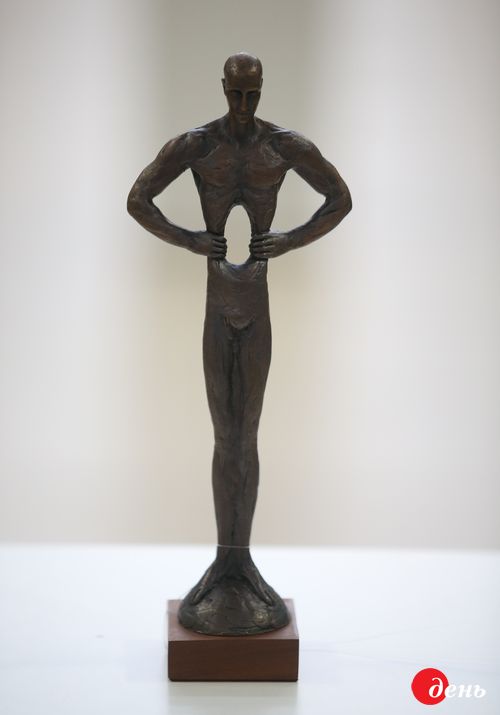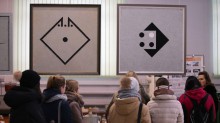The exhibit can be enjoyed at the Polytechnic Museum at the National Technical University of Ukraine (The Kyiv Polytechnic). It is very advantageously displayed against the backdrop of all manner of technical exhibits (which include even rare cars) and consists of Andrii Siderskyi’s paintings and Bohdan Andriitsev’s sculpture pieces. The latter quite deserve a separate personal exhibit. Yet the author says humbly that he created his practicing yogis under the influence of Siderskyi.
A walking legend, a living classic – these are but a few nicknames by which Siderskyi goes. Graduating from the Kyiv Polytechnic in 1984, he gained fame but not as an engineer. In April 2014 the prestigious The Art Newspaper included Siderskyi into its Top 50 most expensive living artists. (Later experts had to point out that Siderskyi is Ukrainian, not Russian.) But even painting is not quite what made him one of the world’s best-known Ukrainians.
Siderskyi is a spiritual teacher (not to be confused with commercial gurus), a role model in the environment of numerous athletes and esoteric seekers of truth. He has been a practicing yogi since the 1970s and one of the best yoga teachers in the West. And also a translator, writer, author of several books of prose and numerous poems. By way of comparison one might say that right now a celebrity of Jiddu Krishnamurti’s caliber is living and working in Kyiv.

Artistic career and success turn out to be the least of Siderskyi’s concerns (and this with an average price of 51,000 pounds per painting, according to TANR). He absolutely does not consider his painting as op art, abstractionism or anything else of that sort. He dubbed his own method Psychotronic Art and describes it as a trend in yoga-art. He explains that in India they have known for thousands of years about this specific spiritual yogi practice in the form of painting, capable of altering the physical characteristics of our world. Ajit Mookerjee described it to the Westerners in detail in his monograph Yoga Art. The 1975 New York edition is also displayed at “The Geometry of Enlightenment.” When Siderskyi told how he managed to find the book with American bookdealers, he was obviously more proud of this stroke of luck than of his own paintings.

ANDRII SIDERSKYI, UNIVERSAL MEDITATIVE SYNDROME. THE MAGIC INK-POT
“Such basic geometrical figures as the point, straight line, circle, triangle, and square, have symbolic value in representing the basic energies of the universe. They can be combined in increasingly complex figures to represent particular forces or qualities embodied in some aspect of creation, evolution, dissolution. … A square, for instance, represents a degree of creation in process; this configuration determines that the creation is to be complete in itself, while a rectangle with unequal sides would indicate a partial or preliminary state of creation. … Color-waves represent a dynamic rush of forces,” writes Mookerjee. Siderskyi’s geometrical abstractions also represent quite utilitarian concreteness. Each of his works is not just a set of colored geometrical symbols. It is a well-thought artistic gesture, aimed at making an impact on the universe. In other words, Siderskyi paints to solve concrete problems of concrete people. “They are wholesome,” declares he. For instance, Five Magical Objects underwent five or more overhauls. The flowers against a menacing yellow background were meant to help a certain person cope with chronic migraine.

BOHDAN ANDRIITSEV, RELYING ON INNER SPACE
It is up to everyone to decide whether they will or not believe in the mystic power of painting. We were impressed not only by the level of Siderskyi’s paintings, but also by a very fortunate solution the curators found for the exhibit. It fits the space of the Polytechnic Museum perfectly, even the color scheme of some paintings is consonant with the exhibits on permanent display next to them. Director Natalia PYSAREVSKA mentioned to The Day that the museum of the Kyiv Polytechnic has an own standpoint in the argument between “artists and engineers.” “Creativity lies at the heart of sciences,” explained Pysarevska. “That is why we intend to further expand cooperation with contemporary art. Of course, we will only invite those authors whose works fit into our concept.”
“For me Andrii is a living legend. The paintings of the yogi Siderskyi are engineer Sikorsky meeting avant-garde artist Kandinsky,” wrote author Liubko DERESH sharing his impressions from the opening. “At some point I even asked permission to use one of his works on the cover of my new novel.”







